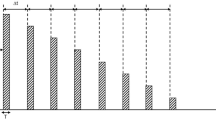Abstract
Objective
131I-meta-iodo-benzyl-guanidine (131I-MIBG) therapy has been used in children with high-risk neuroblastoma, who, in Japan, are cared for by trained nurses. To determine the safety of occupational radiation exposure in nurses, we retrospectively examined radiation exposure during therapy.
Methods
Sixty-two nurses who received radiation exposure during 131I-MIBG therapy were assessed for the daily percentage of total radiation exposure received using the formula, daily radiation exposure/total radiation dose × 100; self-care score of children was evaluated.
Results
Fifty-four 131I-MIBG treatments (592 ± 111 MBq/kg) were performed in neuroblastoma patients (M/F; 27 /27, mean age at 131I-MIBG treatment; 7 ± 2 years), who were isolated for 5 ± 1 days. Average total (0.36 ± 0.18 mSv; range 0.09–0.97 mSv) and daily (0.07 ± 0.05 mSv/day; range 0.02–0.32 mSv/day) radiation exposure to nurses per patient care. The daily percentage of total radiation exposure significantly decreased in 3 days after 131I-MIBG treatment (days 0, 1, and 2 was 38.2 ± 14.7%, 26.9 ± 12.6%, and 15.3 ± 7.1%, respectively), and the average self-care score was 12.2 ± 3.5 (10–27) for all patients. Higher self-care score was significantly related to younger patients’ age and higher daily radiation exposure in nurses.
Conclusion
Individual exposure to radiation was well controlled. Nurses who care for pediatric patients needing daily assistance must be aware of the radiation exposure risks, which can be reduced by establishing a care system and monitoring radiation exposure.



Similar content being viewed by others
References
Kayano D, Kinuya S. Iodine-131 metaiodobenzylguanidine therapy for neuroblastoma: reports so far and future perspective. Sci World J. 2015;2015:189135. https://doi.org/10.1155/2015/189135.
Barnes JA, de la Guardia M, Easley T, Downs H, Mims S, Nielson K, et al. Radiation safety aspects of Iodine-131 metaiodobenzylguanidine (131I mIBG) therapy program startup. Health Phys. 2018;115:776–86. https://doi.org/10.1097/Hp.0000000000000905.
Hjornevik T, Martinsen AC, Hagve WE, Andersen MW, Mørk AC, Fjeld JG, et al. Experiences from introducing standardized high dose 131I-mIBG treatment of children with refractory neuroblastoma: differences in effective dose to patients and exposure to caregivers. J Nucl Med Radiat Ther. 2015;6:6. https://doi.org/10.4172/2155-9619.1000258.
Markelewicz RJ Jr, Lorenzen WA, Shusterman S, Grant FD, Fahey FH, Treves ST. Radiation exposure to family caregivers and nurses of pediatric neuroblastoma patients receiving 131I-metaiodobenzylguanidine (131I-MIBG) therapy. Clin Nucl Med. 2013;38:604–7. https://doi.org/10.1097/RLU.0b013e31829af3c8.
Willegaignon J, Crema KP, Oliveira NC, Pelissoni RA, Coura-Filho GB, Sapienza MT, et al. Pediatric 131I-MIBG therapy for neuroblastoma: whole-body 131I-MIBG clearance, radiation doses to patients, family caregivers, medical staff, and radiation safety measures. Clin Nucl Med. 2018;43:572–8. https://doi.org/10.1097/RLU.0000000000002158.
Han S, Yoo SH, Koh KN, Lee JJ. Estimated internal and external radiation exposure of caregivers of patients with pediatric neuroblastoma undergoing 131I metaiodobenzylguanidine therapy: a prospective pilot study. Clin Nucl Med. 2017;42:271–4. https://doi.org/10.1097/RLU.0000000000001546.
Chu BP, Horan C, Basu E, Dauer L, Williamson M, Carrasquillo JA, et al. Feasibility of administering high-dose (131) I-MIBG therapy to children with high-risk neuroblastoma without lead-lined rooms. Pediatr Blood Cancer. 2016;63:801–7. https://doi.org/10.1002/pbc.25892.
Cougnenc O, Defachelles AS, Carpentier P, Lervat C, Clisant S, Oudoux A, et al. High-dose 131I-MIBG therapies in children: feasibility, patient dosimetry and radiation exposure to workers and family caregivers. Radiat Prot Dosim. 2017;173:395–404. https://doi.org/10.1093/rpd/ncw030.
Gains JE, Walker C, Sullivan TM, Waddington WA, Fersht NL, Sullivan KP, et al. Radiation exposure to comforters and carers during paediatric molecular radiotherapy. Pediatr Blood Cancer. 2015;62:235–9. https://doi.org/10.1002/pbc.25250.
Chuamsaamarkkee K, Charoenphun P, Kamwang N, Monthonwattana S, Changmuang W, Thongklam K, et al. Radiation monitoring of non-lead-lined treatment room in general pediatric ward and adjacent areas for high dose 131Iodine-mIBG. J Pol Soc Med Phys. 2018;24:133–6. https://doi.org/10.2478/pjmpe-2018-0019.
Giammarile F, Chiti A, Lassmann M, Brans B, Flux G. EANM procedure guidelines for 131I-meta-iodobenzylguanidine (131I-mIBG) therapy. Eur J Nucl Med Mol Imaging. 2008;35:1039–47. https://doi.org/10.1007/s00259-008-0715-3.
131I-MIBG Treatment for High-Risk Neuroblastoma. A Guide for Family Caregivers. https://www.sickkids.ca/PDFs/centres/gfcc/60936-SickKids%20MIBG%20Parent%20Education%20Guide.pdf. Accessed 26 Feb 2020.
Yokoi K, Togino Y, Yoshino T, Nagano M, Hyakuman M, Koshino M. An investigation of utility of care manual in 131I-MIBG treatment forpediatric patients (Japanese). In: Abstracts of the 47th Annual Scientific Meeting of the Japanese Society of Nuclear Medicine, Kakuigaku, 2007. p. 324.
Kinuya S, Yoshinaga K, Higuchi T, Jinguji M, Kurihara H, Kawamoto H. Draft guidelines regarding appropriate use of (131)I-MIBG radiotherapy for neuroendocrine tumors: Guideline Drafting Committee for Radiotherapy with (131)I-MIBG, Committee for Nuclear Oncology and Immunology, The Japanese Society of Nuclear Medicine. Ann Nucl Med. 2015;29:543–52. https://doi.org/10.1007/s12149-015-0960-z.
Acknowledgements
We gratefully acknowledge the work of past and present nurses and physicians of nuclear medicine in our isolation ward.
Author information
Authors and Affiliations
Corresponding author
Ethics declarations
Conflict of interest
S.K. has a funded research project collaboration with FUJIFILM Toyama Chemical Co., Ltd. The remaining authors declare that they have no conflict of interest.
Additional information
Publisher's Note
Springer Nature remains neutral with regard to jurisdictional claims in published maps and institutional affiliations.
Rights and permissions
About this article
Cite this article
Taniguchi, Y., Wakabayashi, H., Inaki, A. et al. Radiation exposure in nurses during care of 131I-MIBG therapy for pediatric patients with high-risk neuroblastoma. Ann Nucl Med 34, 441–447 (2020). https://doi.org/10.1007/s12149-020-01466-7
Received:
Accepted:
Published:
Issue Date:
DOI: https://doi.org/10.1007/s12149-020-01466-7




